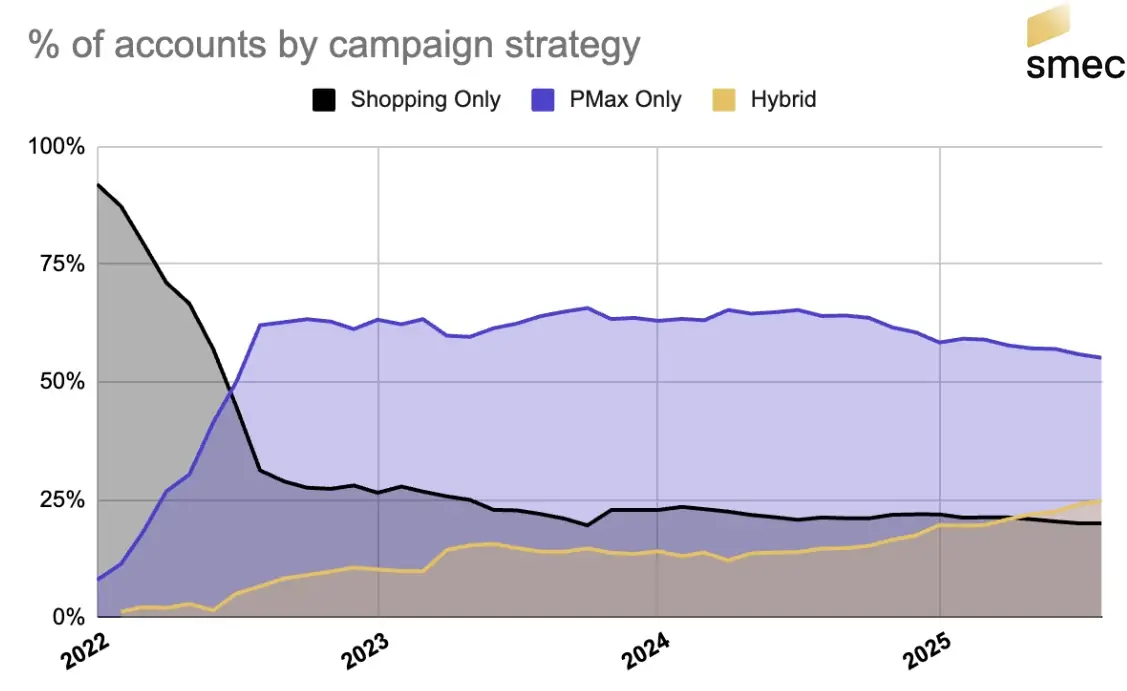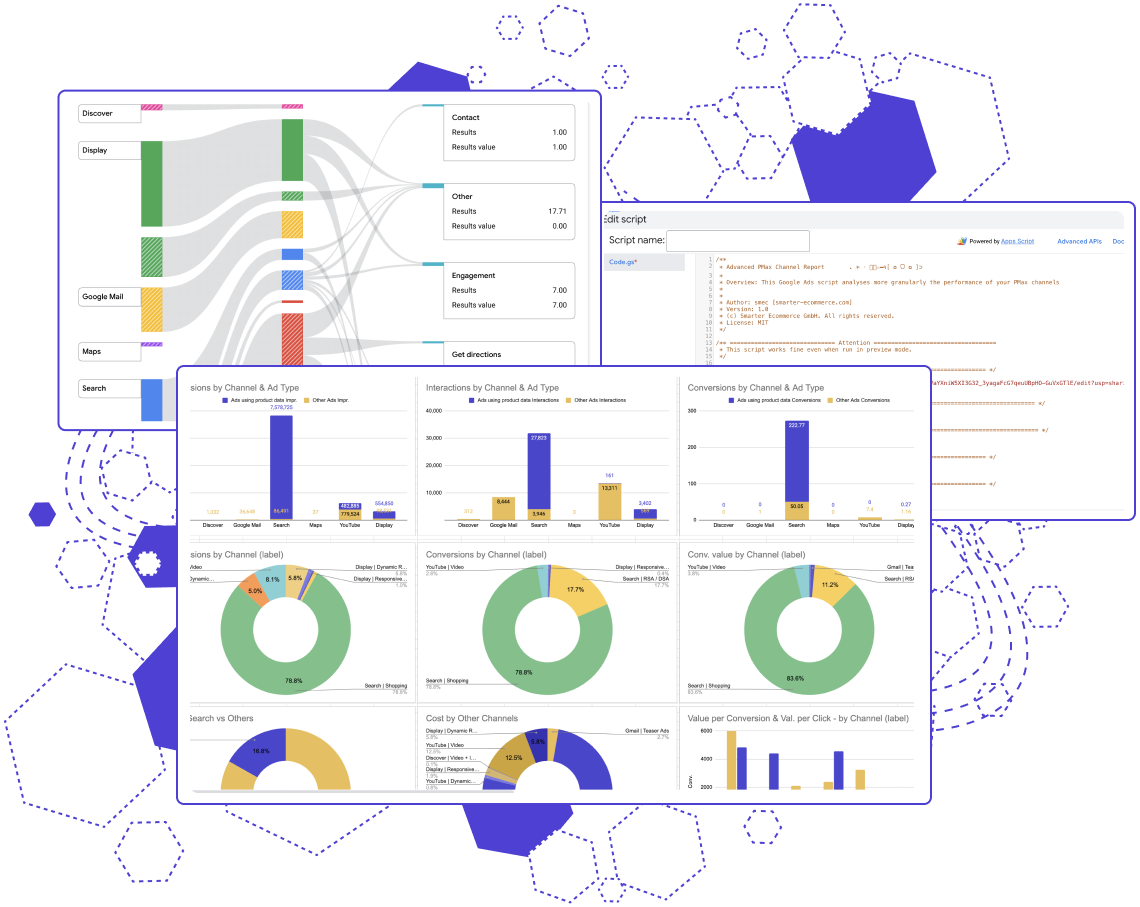Subscribe to join thousands of other ecommerce experts

Google’s “AI Power Pack” marks a fundamental shift away from a single-campaign mindset to a comprehensive, full-funnel advertising strategy. This framework coordinates three specialized AI campaigns: Demand Gen to build awareness, AI Max for Search to discover and capture new intent, and Performance Max to efficiently drive final conversions. However, simply activating these tools is not enough; their power comes from a deliberate, human-led strategy that sets distinct goals, KPIs, and protective guardrails for each. This guide breaks down how to manage this powerful trio in synergy, preventing budget waste and ensuring that higher risks truly lead to bigger rewards.
The playbook for Google Ads has fundamentally changed. For years, the strategy was a dead sprint toward a single goal: Performance Max.
Now, we’re running a marathon.
Google’s new “AI Power Pack” has transformed the race into a three-stage relay. Demand Gen starts the run, AI Max for Search maintains the momentum, and Performance Max drives it home. The old mentality of “all roads lead to PMax” is no longer sufficient.
So, what does this new tripartite structure mean for your ad performance, and what’s the right way to manage it? Here’s the breakdown:
Table of Contents
What is Google’s AI Power Pack?
Let’s rewind for a second.
It all began with a trend our Head of Ecommerce Insights, Mike Ryan, dubbed “PMaxification”—the period starting in 2022 when Google started aggressively consolidating campaigns like Smart Shopping and Local into the all-in-one “black box” of Performance Max.
Not everyone loved it.
Fast forward to Google Marketing Live 2025 and something interesting happened: Google didn’t just double down — they changed the script.
Enter: the Power Pack. A neat little bundle of three campaign types — AI Max for Search, Demand Gen, and PMax — designed to “cover the entire customer journey” (Google’s words, not ours). All AI-powered, of course. Because what isn’t, these days?
Here’s where things get spicy. While Demand Gen followed Google’s classic playbook of “upgrade-or-else” (RIP Discovery Ads), they took a softer route with Search: introducing “AI Max” as a feature, not a forced migration. At least for now.
That’s right — instead of yanking the steering wheel away, they’re letting advertisers opt-in. A far cry from the abrupt PMax rollout.
And just like that, we find ourselves in a new era of Google Ads — where AI isn’t just powering campaigns, it’s trying to orchestrate them. In today’s landscape, we are experiencing a fundamental shift in how Google’s ad ecosystem works:

Demand Gen: The architect of future demand
As the successor to Discovery, Demand Gen is Google’s first truly dedicated tool for the mid-funnel. It’s built for creating awareness, not for immediate conversion. It operates on visually-rich platforms like YouTube, Discover, and Gmail, where users are in a mindset of exploration and open to new brands.
- ✨ The opportunity: This is your primary tool for generating future customers. It allows you to connect with audiences based on their interests and online behaviors before they even begin actively searching for a product like yours. With Demand Gen, you can deploy more creative, narrative-driven ads to build brand equity and cultivate the audience that PMax will later convert.
- 🚧 The risk: The main danger with Demand Gen stems from a fundamental misunderstanding of its role. Advertisers fixated on hitting a daily ROAS target will likely view Demand Gen as an underperformer. This campaign is a long-term play. Its value is strategic, and its impact is often indirect, as we’ll see.

Data source: smec
AI Max for Search: The engine for expansion
AI Max is not an entirely new campaign type; it’s an AI-driven layer that takes over your traditional Search campaigns. As we’ve covered before, AI Max operates beyond your manually selected keyword lists, targeting users based on the AI’s real-time interpretation of their broader intent. Essentially, it integrates PMax’s expansion logic directly into your classic search framework.
- ✨ The opportunity: For well-established accounts that have exhausted their growth potential with existing keyword strategies, AI Max provides a powerful new avenue for expansion. It can autonomously discover new, relevant query territories and capture long-tail search intent that you may not have known existed.
- 🚧 The risk: This is a high-powered engine that currently lacks robust safety features. Its default setting is aggressive expansion. For example, in one account we monitored, a staggering 69% of all AI Max impressions were for the brand terms of our client’s largest competitor. We’ve also consistently observed its tendency to favor high volumes of lower-quality traffic from the Search Partner Network. To counteract these risks, we recommend:
- Building comprehensive negative keyword lists targeting competitor brand terms.
- Proactively excluding the Search Partner Network from campaigns.

Data source: smec
Performance Max: The conversion powerhouse
PMax is still the anchor of this strategy, but its function is now more sharply defined as the dedicated bottom-funnel conversion engine. It leverages your creative assets and product feed to find users ready to convert across Google’s entire inventory—Search, Shopping, YouTube, Display, and more—with a singular mission: to maximize performance through sales or leads.
- ✨ The opportunity: PMax is exceptionally efficient at capturing existing demand. If you have solid brand recognition and a consistent flow of high-intent traffic, it excels at identifying the most cost-effective path to a conversion. This dramatically simplifies the process of cross-channel media buying for direct-response objectives.
- 🚧 The risk: Since PMax and Demand Gen both operate across many of the same channels, there’s a considerable risk that PMax will cannibalize the audience and impact of your Demand Gen campaigns. To ensure they work in harmony, you must return to their core purposes. This means defining distinct conversion goals and KPIs for each campaign:
- Optimize Demand Gen toward mid-funnel actions like ‘add-to-cart’ or newsletter subscriptions.
- Set PMax to focus exclusively on hard conversions like ‘purchase’ as its primary goal.

Diagram: smec
How the trio works in concert
Each campaign in Google’s Power Pack has a distinct function, but its true potential is only unlocked when they operate as a single, integrated system.
- Demand Gen initiates the play. It builds awareness and piques curiosity with engaging creative, making the first contact with audiences who aren’t yet in the market for your solution.
- AI Max for Search captures that initial spark. It translates curiosity into active intent by expanding your reach into new, related search queries, bridging the gap between discovery and research.
- Performance Max closes the deal. It takes this warmed-up audience and efficiently converts them into customers across Google’s network.
This process should function as a continuous loop, not a linear funnel. However, this synergy is not automatic. Without a coherent strategy, the very automation designed to create harmony can instead produce chaos.
How to master the Power Pack 💡
While it’s wise to remain skeptical, Google’s pitch for the AI Power Pack is strategically sound. It addresses the fears of many marketers who were wary of the “all roads lead to PMax” future by segmenting the funnel into distinct campaigns with clear roles.
But more options create more opportunities for error. This new environment demands a strategic framework rooted in data. Here’s the approach our strategists are implementing:
- Audit your funnel, not your accounts: Clearly define the role of each tool. Use Demand Gen to create awareness, PMax to drive conversions, and AI Max (with caution) to expand your reach. Ensure these roles are distinct and not competing for the same budget and goals.
- Match KPIs to the job: Evaluate each campaign based on its strategic function. Abandon the one-size-fits-all ROAS target. If you cannot effectively measure the value of brand awareness, you shouldn’t be investing in awareness campaigns.
- Establish guardrails from the start: These new AI tools are expansionary by design. The human strategist is the only one who can define the boundaries. We strongly advise using robust negative keyword lists, placement exclusions, and dedicated brand defense campaigns to keep the AI in check and protect your budget.
A look to the future
With the Power Pack, Google is making a bigger bet on AI, but it is not replacing the strategic PPC marketer who manages the system.
Each campaign—Demand Gen, AI Max, and PMax—is responsible for its own leg of the race. But it’s your job as the strategist to set the pace, manage the handoffs, and ensure the entire system reaches the finish line effectively.
Keep your eyes on the data, adjust your strategy, and maintain control. In this new marathon of Google Ads, it’s not just speed that wins the race—it’s clarity, coordination, and strategy.
Frequently Asked Questions
While AI Max might be giving you a better ROAS via Search Partner placements, this short-term gain could lead to bigger problems down the road.
On one hand, Search Partner Network (SPN) traffic is often harmless because the intent is so low that it often fails to generate clicks (and therefore costs).
On the other hand, when it does spend, we’ve typically seen ROAS about 37% lower. Likely due to AI Max’s tendency to go after brand terms the algorithm deems profitable.
When that happens, you are forced to bid higher to maintain visibility and potentially drive up everyone’s costs.
To mitigate the risks, we highly suggest using negative keyword lists for competitor terms and be more proactive with SPN exclusions if it doesn’t align with your goals.
There is a very, VERY fundamental misunderstanding of what Demand Gen is designed to do. Demand Gen is NOT a direct conversion tool.
Demand Gen is a mid-funnel campaign type, first and foremost. It’s designed to build awareness and get people to discover your brand who haven’t heard of you yet.
Setting a tight ROAS target risks making the campaign too competitive with the prospecting (and potentially even the remarketing) inside of Performance Max.
Instead, we recommend using Max Conversions with a soft conversion target, like an add-to-cart or a newsletter sign-up, or Max Clicks.
This allows Demand Gen to do its job of filling the top of your funnel without interfering with your high-value campaigns.
Additionally, Google now offers brand lift and search lift studies, as well as a new conversion type called branded searches to measure Demand Gen’s less direct effects.
Legacy campaigns are not dead! They are still incredibly powerful tools that serve specific strategies.
This misconception that old-school campaign types are somehow obsolete stems from Google’s previous strategy to push everything into PMax.
This has changed! We’ve seen sales pitches from Google reps themselves for “hybrid PMax and Shopping” setups.
Until a year ago, we too drank the “all roads lead to PMax” Kool-Aid. In reality, the Power Pack is more of a “PMax leads to all sorts of intersections”-strategy.
In other words: You should absolutely feel emboldened to experiment with classic campaign types in conjunction with Google’s new, powerful AI tech.
This is not expected behavior!
According to Google’s own support documentation, AI Max is supposed to honor your negative keywords.
So if this happened to you, this leakage is likely a bug in the early stages of the technology and will hopefully be fixed in future updates.
However: If you see this happening, you should verify the problem, and bring it to your Google representative immediately!
For a more in-depth strategic breakdown of Google’s new AI campaign technology, watch our full webinar with Mike Ryan, now streaming on YouTube:

